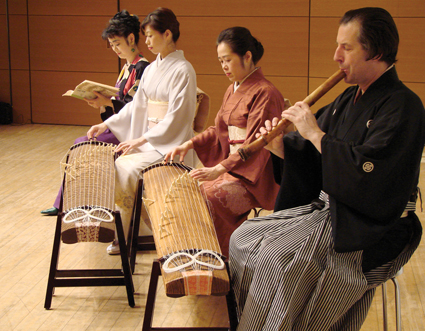Gagaku word means elegant, correct, or refined music. In the Heian period (7th cent.), More than thirty kinds of instuments used to perform music from China, Korea, India, and the original Japanese music. Gagaku is a significant form of early Japanese music. This shares with Kabuki musical instuments differ in each of the three basic orchestra units, percussion, strings, and wind. Although not taking full advantage of orchestral possibilites, as not Kabuki, it is considered by some to be the only "true" orchestra music from Japan.

There are four types of Gagaku --
· KANGEN instrumental Japanese music
· BUGAKU dance Japanese music
· SONGS
· RITUAL MUSIC for the Shinto ceremony
Bugaku now, and Sam, are classified into two groups. Saho (left) and UHO (right). Saho left the music consists of music from China and some parts originating in India. Uho appropriate music mostly from Korea and a few pieces of Manchuria. This classification seems to represent a combination Japan's ancient idea that the left, sometimes associated with the spiritual and peaceful, more superior to the right, which is more physical and worldly. Also, the fact that at that time, China is more popular music than Korean music. Music pieces composed in Japan are also classified in the right or left the force.
Gagaku repertoire pieces further classified be small, medium, and large pieces. Differences may derived from the number of

players required to accompanies the dance. Large and medium-sized pieces usually followed JO-HA KYU-form, although there indications that some parts have a front, EI, between HA and KYU section. This is the style many traditional arts in Japan. They mean, (slow) introduction, (faster) development, and (quickly) breaks or conclusions. Smaller pieces tend to have only the HA and KYU. The tempi are generally very slow and the difference between slow and fast does not vary much the extent of Western music.
Another important performance style is a kind of free cannon style. Jo movement in performance (left) Bugaku, the principle Sho (mouth organ) began melody. Then the players started the second Sho some beats later. He was followed by a third. Head HICHIRIKI (oboe) joined the group Sho, the second player in the back him and so forth. The Flutists join the same ensemble fashion. Thus the entire group of three different wind forming part of the cannon freestyle in free rhythm to create a chaotic sound very dynamic. Same performance style is found in six pieces called CHOSHIN. CHOSHIN used for the entrance to the dancers stage.

Gagaku is a lot of fun old-fashioned sense. For those who are familiar with the dynamic drive West symphonic music, Gagaku static beauty may seems very strange. Listening Gagaku is history lessons in voice and a "time machine" trip back to Heian court life. Like standing, it is the shadow from us before and yet still one of the most obvious left view the grandeur and artistic ancient Japanese music court. By Timothy Jordan